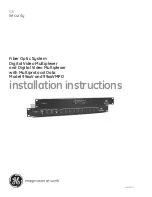
65
64
APPENDIX C - ACCESSORIES
PROBES packed in carton box, without sensors or protective shield
HI 7698194/4
HI 7698194
probe with 4 meter (13.1’) cable
HI 7698194/10
HI 7698194
probe with 10 meter (33’) cable
HI 7698194/20
HI 7698194
probe with 20 meter (65.6’) cable
HI 7698194/40
HI 7698194
probe with 40 meter (131.2’) cable
HI 7698195/4
HI 7698195
probe with 4 meter (13.1’) cable
HI 7698195/10
HI 7698195
probe with 10 meter (33’) cable
HI 7698195/20
HI 7698195
probe with 20 meter (65.6’) cable
HI 7698195/40
HI 7698195
probe with 40 meter (131.2’) cable
HI 7698196/4
HI 7698196
probe with 4 meter (13.1’) cable
HI 7698196/10
HI 7698196
probe with 10 meter (33’) cable
HI 7698196/20
HI 7698196
probe with 20 meter (65.6’) cable
HI 7698196/40
HI 7698196
probe with 40 meter (131.2’) cable
Note: • Probes with different cable length are available upon request.
• Order protective shields separately.
The probe is suitable for measurements in a flow cell. Pumping water to a
flow-through monitoring station has obvious pros and cons. Typically a shelter is
required to secure a pump, and flow chamber. A power requirement, shelter,
pump maintenance and higher installation cost need to be considered. Freeze
protection, security, and convenience of calibration and possibility of adding
multiple measurement points and antifouling preconditioning systems are
advantages to this type of installation.
General Guidelines for fixed installation:
• Select a water-sampling site that will allow collection of representative water
samples.
• Position the probe so the sensor surfaces face toward the flow. This will minimize
air bubble or fluid cavitation. Limit flow rate to moderate.
• Mount Probe 0 to 45° angle from vertical to avoid sensors (pH, pH/ORP) from
becoming electrically discontinuous due to internal electrolytes flowing away
from their internal cells.
• Install meter and probe where they will be accessible for maintenance as
required.
• Regularly visit water sampling sites to: check for damage to sensors, the
installation mountings, and the meter battery power.
• Remove aquatic weed growth that may be interfering with water sample
collection.
• Set up devices and programs for water monitoring and sampling.
• If the probe is suspended from a pier or bridge ensure that it is protected from
debris by positioning behind a support and anchoring the cable /probe to a
pipe.
• Have access to spare sensors and proper range standard solutions or buffers.
• Strictly follow the established SOP’s.
• Flow cell installation; Avoid trapped air. Maintain constant flow rate.





































